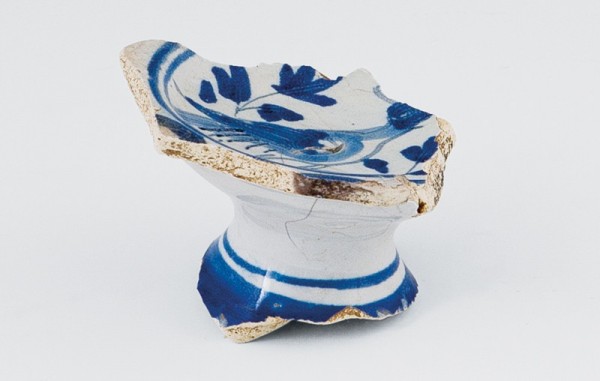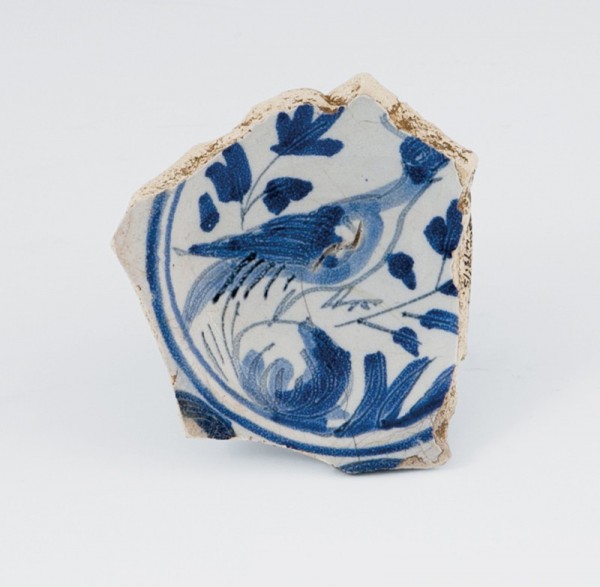
Salt, probably London, England, ca. 1650–1700. Tin-glazed earthenware. H. 2 1/2". (Courtesy, Flowerdew Hundred Collection, University of Virginia Library; photo, Robert Hunter.)

View of the shallow bowl of the salt illustrated in fig. 1, with hand-painted, cobalt-blue bird-and-foliage decoration.
Minges Ferry is one of many culturally significant archaeological sites located at Flowerdew Hundred in Prince George County, Virginia. On the south bank of the James River, this plantation was granted to Sir George Yeardley in 1619 and named for his wife, Temperance (née Flowerdew). In the 1980s the roughly crescent-shaped site, which was first recognized in the mid-1970s during spring plowing, yielded more than two thousand pipe-stem fragments in a controlled surface survey. Dating from circa 1650 to 1770, Minges Ferry has had the longest occupation of any site at Flowerdew Hundred.[1]
In 1673 the one-thousand-acre Flowerdew Hundred tract was divided into two equal parts by James Minge, surveyor and clerk of the House of Burgesses, for sisters who had inherited it from their brother John Barker. The lower dividend was attained by Sara and her husband, Robert Lucy. The upper dividend, which included Minges Ferry, was owned by Elizabeth and her husband, Philip Limbrey.[2]
More than three decades ago, a small blue-on-white tin-glazed earthenware vessel was recovered during a random surface survey at Minges Ferry. Recently returned to the Flowerdew Hundred collection, the form is unique among the thousands of ceramic objects found at Flowerdew. A small footed dish for holding salt, known as a salt or saltcellar, this vessel type was used on the tables of the economically and socially advantaged when salt was a precious commodity (fig. 1).[3]
The Minges Ferry salt is hand painted under the glaze in two tones of cobalt blue, with a bird-and-foliage design on the interior of the shallow bowl (fig. 2). Two concentric bands surround the central design just below the rim. The fragmented hollow pedestal foot is encircled with two horizontal stripes, and traces of a swaglike motif decorate the flat rim. It is impossible to determine whether rim knobs or supports are missing, but if they are, only three would have surmounted a circular salt such as this.[4] Despite a wealth of published knowledge and consultation with delft experts, the date and origin of the salt have yet to be firmly identified. The object resembles a London delftware saltcellar, formerly in the Longridge collection, that is decorated in rich cobalt blue and is dated “1675.”[5] Likewise, it is similar to a Chinese porcelain example made for the European market in Jingdezhen during the Kangxi period, circa 1662–1722.[6]
Although antique salts in diverse forms and materials are found in many English, European, and American museums, they are unusual in colonial American archaeological assemblages. Nevertheless, several English delftware examples were found on other seventeenth-century sites in nearby James City County, where extensive excavations were carried out in the second half of the twentieth century. These include one each at Kingsmill Tenement, the Joseph Petitt site, and Martin’s Hundred.[7] It is tantalizing to think that the Minges Ferry salt, probably made in London sometime in the second half of the seventeenth century to circa 1700, might once have graced the table of Elizabeth Limbrey.[8]
Karen K. Shriver, Curator, Flowerdew Hundred Collection, University of Virginia Library
ks2kc@virginia.edu
Brenda Butler, Field Notes, 1983–1986 (Charlottesville: Flowerdew Hundred Collection, University of Virginia Library). See also “Flowerdew Hundred Historic Site Survey, 44PG103,” unpublished report, Flowerdew Hundred Collection, University of Virginia Library, Charlottesville, 1983.
Eve S. Gregory, “Flowerdew Hundred—an Historical Report,” Appendix D, unpublished report, Flowerdew Hundred Dividend, 1976, Flowerdew Hundred Collection, Morven Guest House.
For a link to saltcellars dating from the first century to circa 1600, see www.larsdatter.com/ saltcellars.htm (accessed March 7, 2011).
Leslie B. Grigsby, The Longridge Collection of English Slipware and Delftware, vol. 2, Delftware (London: Jonathan Horne Publications, 2000), p. 232. This reference includes a comprehensive discussion of delftware salt forms.
Ibid., pp. 232–33.
A photograph and catalog record of this item in the British Museum can be viewed online at http://collections.vam.ac.uk/item/O494256/salt-cellar/ (accessed March 7, 2011).
Ivor Noël Hume, Early English Delftware from London and Virginia (Williamsburg, Va.: Colonial Williamsburg Foundation, 1977), p. 29, pl. 16, p. 67, fig. VI, nos. 14, 15. See also John C. Austin, British Delft at Williamsburg (Williamsburg, Va.: Colonial Williamsburg Foundation, in association with Jonathan Horne Publications, 1994), p. 189.
John C. Austin, former curator of ceramics for the Colonial Williamsburg Foundation, suggests the salt was probably made in London circa 1700 (personal communication, December 2010). Michael Archer, author of many books on English and Dutch delftware, believes it is most likely Dutch and probably was made in the second half of the seventeenth century (email communication, January 2011).
